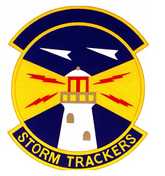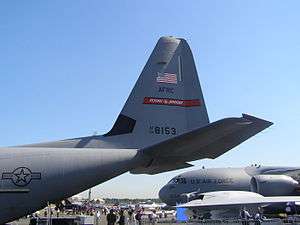815th Airlift Squadron
| 815th Airlift Squadron | |
|---|---|
|
815th Airlift Squadron C-130J tail showing the Flying Jennies tail band | |
| Active |
14 September 1943 – 25 September 1945 1 January 1953 – 15 December 1969 25 April 1973 – Present |
| Country |
|
| Branch |
|
| Type | Airlift |
| Part of | 403d Operations Group |
| Garrison/HQ | Keesler Air Force Base, Mississippi |
| Nickname(s) | Flying Jennies, Storm Trackers (1976-1987) |
| Engagements |
|
| Decorations |
|
| Insignia | |
| Emblem of the 815th Airlift Squadron (approved 28 April 1960, reinstated 1988)[1] |
 |
| 815th Weather Reconnaissance Squadron emblem |
 |
The 815th Airlift Squadron is a flying unit of the United States Air Force assigned to the Air Force Reserve Command and part of the 403d Wing at Keesler Air Force Base, Mississippi. It operates C-130J Hercules aircraft providing global airlfit.
During World War II as the 815th Bombardment Squadron, it was one of the last B-17 Flying Fortress heavy bomber squadrons deployed to Southern Italy as part of the Fifteenth Air Force 483d Bombardment Group in March 1944.
Mission
Support the theater commander with the capability to resupply the forces, provide for their airlift requirements and employment operations within the combat zone or forward areas, and when requested, to provide aeromedical/refugee evacuation and augment strategic airlift forces. The unit can perform precision air drop of supplies and paratroopers in all weather conditions either day or night, as well as perform day and night assault zone loadings.
History
World War II

Established in late 1943 as a B-17 Flying Fortress heavy bombardment squadron, trained under Third Air Force in Florida. Was deployed to the Mediterranean Theater of Operations (MTO), being assigned to Fifteenth Air Force in Southern Italy. Engaged in long-range strategic bombardment of enemy military, industrial and transport targets, including oil refineries and production oilfields in Italy, France, southern Germany, Austria and the Balkans. Continued strategic bombardment until German capitulation in May 1945.
After V-E Day, was assigned to Air Transport Command (ATC) Green Project which was the movement of troops from Pisa Airfield staging area in Morocco. B-17s were dearmed with flooring and seats for 25 passengers installed. Crew consisted of Pilot, Co-Pilot, Navigator and Flight Engineer. Carried passengers from Pisa to Port Lyautey Airfield, French Morocco where ATC transports moved them across the Atlantic or to Dakar for movement via South Atlantic Transport Route. Inactivated in Italy in September 1945.
Cold War
Reactivated by Far East Air Forces in 1952 in Japan as a C-119 Troop Carrier squadron. Engaged in combat operations in South Korea transporting personnel and supplies to front-line units, under hazardous conditions. Also evacuated wounded personnel to hospital facilities in South Korea and Japan. Remained in Japan after the 1953 Armistice, providing intra-theater transport within Japan, South Korea and Okinawa, in 1958 was re-equipped with C-130 Hercules aircraft.
Continued intra-theater transport operations, also flying to locations in the Philippines, Thailand and Indochina, supporting United States civilian and military personnel assigned to the region. As the United States increased its combat presence in Indochina in the early 1960s, made frequent flights to airfields in South Vietnam and to locations within the country. As in South Korea, the flights within South Vietnam were extremely hazardous as the squadron operated within combat areas and frequently were under fire from communist forces during takeoff, landing and ground operations. Inactivated in December 1969 as part of the drawdown of US forces in Southeast Asia, and reactivated in April 1973 at Keesler Air Force Base, Mississippi, as a unit of the Air Force Reserve.
Air Force Reserve
It performed weather reconnaissance from 1983–1987, including flying into hurricanes to collect atmospheric data and retained weather reconnaissance capability until 1992. It had tactical airlift responsibilities from 1973–1975 and since 1987. It also took part in Operation Just Cause in Panama, December 1989-January 1990.
The 815th AS was selected in May 1999 as the first unit in the U.S. Air Force to take delivery of the C-130J variant and participated heavily in writing the book for "J" model operations. Along with a sister Air Mobility Command unit, the 41st Airlift Squadron, the 815th AS deployed the C-130J into combat, and bested all previous C-130 squadrons that were previously employed by setting numerous records in the theater for best aircraft availability, missions flown, as well as passengers and cargo carried.[2]
On 6 August 2010 the Air Force activated the 345th Airlift Squadron, an associate squadron composed of active duty personnel, at Keesler and integrated its members in operations of the 815th AS. On 21 March 2013, the 403rd Wing announced that its C-130J aircraft would be redeploying to Pope Air Force Base, North Carolina, beginning in October 2013 in preparation for inactivation of the 815th AS.[3] The transfer was delayed in early 2014 because of pending plans to shut down the airlift wing at Pope and the inactivation of the 815th AS itself delayed on 28 July.[4]
Lineage
- Constituted as the 815 Bombardment Squadron (Heavy) on 14 September 1943
- Activated on 20 September 1943
- Redesignated 815 Bombardment Squadron, Heavy c. September 1944
- Inactivated on 25 September 1945
- Re-designated 815 Troop Carrier Squadron, Medium on 15 November 1952
- Activated on 1 January 1953
- Redesignated 815 Troop Carrier Squadron on 8 December 1965
- Redesignated 815 Tactical Airlift Squadron on 1 August 1967
- Inactivated on 15 December 1969
- Activated in the Reserve on 25 April 1973
- Redesignated 815 Weather Reconnaissance Squadron on 1 January 1976
- Redesignated 815 Tactical Airlift Squadron on 31 December 1987
- Redesignated 815 Airlift Squadron on 1 February 1992[1]
Assignments
- 483d Bombardment Group, 20 September 1943 – 25 September 1945
- 483d Troop Carrier Group, 1 January 1953
- 483d Troop Carrier Wing, 8 December 1958
- 315th Air Division, 25 June 1960[5]
- 374th Tactical Airlift Wing, 1 November 1968 – 15 December 1969
- 920th Tactical Airlift Group (later 920 Weather Reconnaissance Group), 25 April 1973
- 403d Rescue and Weather Reconnaissance (later, 403 Tactical Airlift; 403 Airlift) Wing, 1 November 1983
- 403d Operations Group, 1 August 1992 – present[1]
Stations
- Ephrata Army Air Base, Washington, 20 September 1943
- MacDill Field, Florida, 7 November 1943 – 2 March 1944
- Sterparone Airfield, Italy, 9 April 1944
- Pisa Airfield, Italy, 15 May-25 September 1945
- Ashiya Air Base, Japan, 1 January 1953
- Tachikawa Air Base, Japan, 25 June 1960 – 15 December 1969
- Keesler Air Force Base, Mississippi, 25 April 1973 – present[1]
Aircraft
- B-17 Flying Fortress (1943–1945)
- C-119 Flying Boxcar (1953–1959)
- C-130A Hercules (1958–1969)
- C-130E Hercules (1973–1975, 1988–1998)
- C-130J Super Hercules (1998–Present)
- WC-130 (1976–1990, 1991–1993)[1]
Operations
- World War II
- Korean War
- Operation Just Cause
- Operation Provide Relief
- Operation Provide Promise
- Operation Uphold Democracy
- Operation Restore Hope
- Operation Southern Watch
- Operation Iraqi Freedom
See also
References
Notes
- 1 2 3 4 5 Haulman, Daniel L. (April 7, 2008). "Factsheet 815 Airlift Squadron (AFRC)". Air Force Historical Research Agency. Retrieved September 6, 2016.
- ↑ 815th Airlift Squadron Fact Sheet
- ↑ 403rd Wing losing C-130J aircraft, 403rd Wing Public Affairs (Retrieved 21 March 2013)
- ↑ Air Force Reserve Command delays inactivation of 815th Airlift Squadron, 403rd Wing Public Affairs (Retrieved 28 July 2014)
- ↑ "Factsheet 315 Air Division". Air Force Historical Research Agency. 2007-12-10. Archived from the original on October 30, 2012. Retrieved February 24, 2014.
Bibliography
![]() This article incorporates public domain material from the Air Force Historical Research Agency website http://www.afhra.af.mil/.
This article incorporates public domain material from the Air Force Historical Research Agency website http://www.afhra.af.mil/.
- Maurer, Maurer, ed. (1982) [1969]. Combat Squadrons of the Air Force, World War II (PDF) (reprint ed.). Washington, DC: Office of Air Force History. ISBN 0-405-12194-6. LCCN 70605402. OCLC 72556.
- USAF 815th Airlift Squadron History
- 815th Airlift Squadron Fact Sheet

